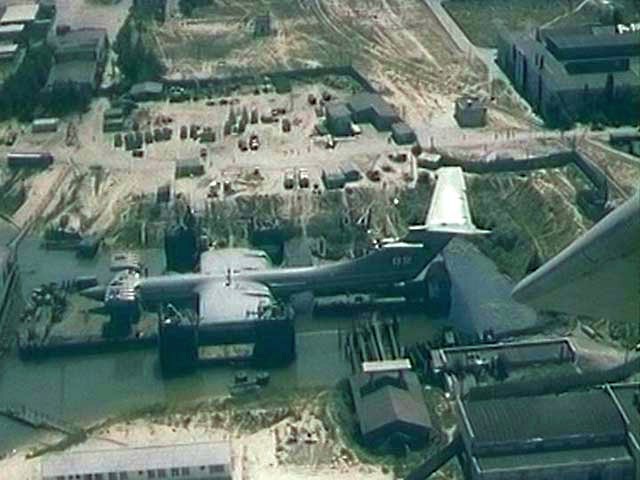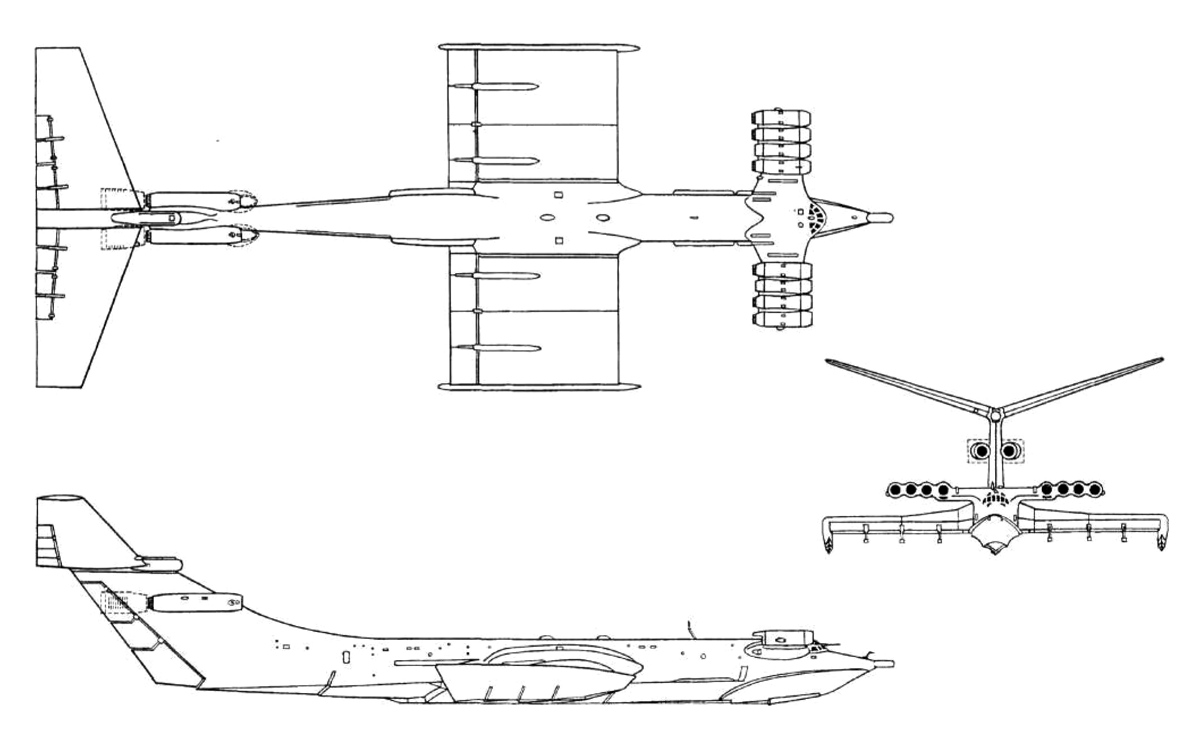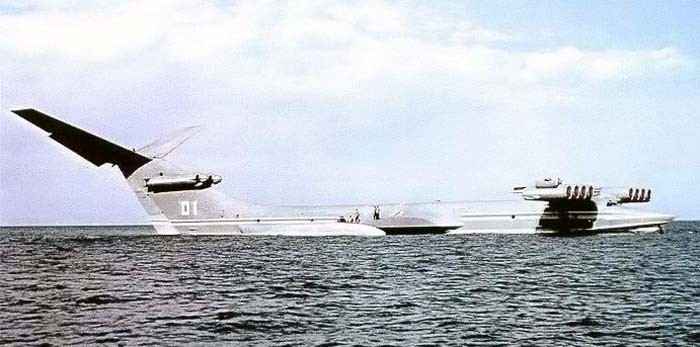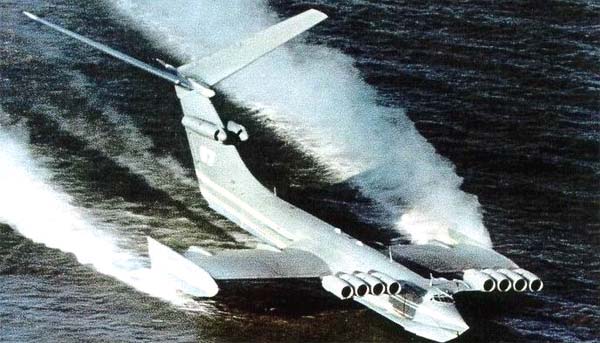"Caspian Monster"
Good day, I’ll try to tell you about the prototype of project 903: “Lun”
Background:
In the summer of 1967, a group of US intelligence analysts gathered in the so-called green room to decode unusual photographs taken by a spy satellite. The plane was visible in the photographs, the dimensions were significantly larger than any bomber or civilian airliner. The plane was in a fenced area near Kaspiysk - a small town on the coast of the Caspian Sea.

For this reason, scouts began to call the giant machine "Caspian Monster." Subsequent considerable efforts of American intelligence allowed to collect only some information. Everything became clear only after the end of the Cold War.
A bit about the principle of the screen
Here we should mention another class of ships that can soar above the surface of the water - the so-called hovercraft. They found application in military affairs and were produced both in the USSR and in foreign countries. The screen effect is used here, but it arises due to the injection of air under the bottom, which has a special shape. Such vessels are capable of speeds of up to 120 kilometers per hour and can easily overcome small shallows, reeds and other similar obstacles. One of these ships was the Soviet "Lynx", equipped with three engines: two of them set the propellers in motion, and the third pumped air under the bottom.
In ekranoplans, the screen effect is used - a change in the wing's bearing properties at low flight altitudes - discovered by aviators in the 1920s. Since the flight data of the aircraft, and in particular, its stability, were not designed for this effect, it in some cases led to accidents and crashes of aircraft during take-off and landing modes of movement. Apparently, one of the first Russian works devoted to the influence of the earth on the aerodynamic properties of a wing was the experimental work of B.N. Yuryev (1923). In the period 1935 - 1937. A set of experimental and theoretical studies in this direction was carried out by Ya.M. Serebriisky and Sh.A. Biyachuev at TsAGI. Around the same period, a number of theoretical studies were conducted by prominent foreign scientists: A. Betz, K. Wieselsberg, S. Hagget, D. Bagley, M. Finn. The results of these studies allowed us to give a qualitative assessment of the effect of the screen effect on the aerodynamic characteristics of a low-flying wing. In particular, it was shown that the lifting force of the wing grows, and the more, the closer the wing is to the ground; the resistance decreases, the longitudinal moment changes. This made it possible to develop appropriate recommendations for controlling an aircraft in which the influence of the screen on the aerodynamic characteristics of the takeoff and landing modes is manifested.
However, for aviation, this effect continues to be “harmful."

This healthy crap “Caspian Monster” was built in 1966 and had 10 turboprop engines - eight on the wings and two on the tail. The length of the aircraft was about one hundred meters, and weight - 540 tons.
The KM, or mock ship, as it was called in the Central Design Bureau, had a length of 92 m, a height of 22 m, and a wingspan of 37 m. On the front pylon there were 8 turbojet engines with a thrust of 10 tons each - their power was used mainly at launch. On the keel there were two more of the same engines, sufficient to maintain the cruising regime. In a record flight, its mass reached 544 tons, which at that time was an unofficial world record for aircraft of that time. He was beaten only with the creation of the An-225 Mriya aircraft .

Achievements of the “Caspian Monster”:
1. For the first time in the world, a heavy seaplane designed for a long cruise flight in the “screen” mode was designed and built
2. For the first time in the world, on a heavy aircraft, the principle of take-off on an air cushion was carried out by blowing gas from marching turbojet engines under the center section;
3. For the first time in the world, when assembling a heavy seaplane, welding of aluminum alloys was widely used.
Tests in which R. Alekseev personally participated showed that for take-off from water it is necessary to disperse the ekranoplan to a speed of 350 km / h. The first flight over the Caspian Sea lasted 50 minutes and took place at an altitude of four meters.
The Caspian Monster became the ancestor of two new machines, and in 1972 the Orlyonok winged landing craft was built, which had more modest parameters (length 58 meters, weight 120 tons). The design was successful. The second ekranoplan, which appeared in 1987, was the Lun combat missile carrier, which was intended to fight warships and had six cruise missiles.

One more valuable property of military ekranoplanes should be noted. Conventional air defense radars have a very short range for low-flying targets. Therefore, ekranoplanes flying at an altitude of several meters are practically invisible on the screens of locators. It was planned to launch the Eaglet in a series, but this did not happen - the military leadership did not show due interest in the new type of military equipment.

CM tests took place in the Caspian for 15 years and ended very sadly. February 9, 1980, Alekseev died. In the same year, KM died. The pilot, who had not sat at the helm of the “monster” for a long time, pulled his nose too sharply when taking off the nose of the car, it quickly and almost vertically went up, the bewildered pilot abruptly threw off the thrust and, according to instructions, did not operate the elevator - the ship, collapsing on the left wing, hit the water . There were no casualties. Everyone who knew the “Caspian Monster” still assures that it was necessary to do something out of the ordinary to ditch it.

ps: Thanks vaproldj for the story about the Lun project
Background:
In the summer of 1967, a group of US intelligence analysts gathered in the so-called green room to decode unusual photographs taken by a spy satellite. The plane was visible in the photographs, the dimensions were significantly larger than any bomber or civilian airliner. The plane was in a fenced area near Kaspiysk - a small town on the coast of the Caspian Sea.

For this reason, scouts began to call the giant machine "Caspian Monster." Subsequent considerable efforts of American intelligence allowed to collect only some information. Everything became clear only after the end of the Cold War.
A bit about the principle of the screen
Here we should mention another class of ships that can soar above the surface of the water - the so-called hovercraft. They found application in military affairs and were produced both in the USSR and in foreign countries. The screen effect is used here, but it arises due to the injection of air under the bottom, which has a special shape. Such vessels are capable of speeds of up to 120 kilometers per hour and can easily overcome small shallows, reeds and other similar obstacles. One of these ships was the Soviet "Lynx", equipped with three engines: two of them set the propellers in motion, and the third pumped air under the bottom.
In ekranoplans, the screen effect is used - a change in the wing's bearing properties at low flight altitudes - discovered by aviators in the 1920s. Since the flight data of the aircraft, and in particular, its stability, were not designed for this effect, it in some cases led to accidents and crashes of aircraft during take-off and landing modes of movement. Apparently, one of the first Russian works devoted to the influence of the earth on the aerodynamic properties of a wing was the experimental work of B.N. Yuryev (1923). In the period 1935 - 1937. A set of experimental and theoretical studies in this direction was carried out by Ya.M. Serebriisky and Sh.A. Biyachuev at TsAGI. Around the same period, a number of theoretical studies were conducted by prominent foreign scientists: A. Betz, K. Wieselsberg, S. Hagget, D. Bagley, M. Finn. The results of these studies allowed us to give a qualitative assessment of the effect of the screen effect on the aerodynamic characteristics of a low-flying wing. In particular, it was shown that the lifting force of the wing grows, and the more, the closer the wing is to the ground; the resistance decreases, the longitudinal moment changes. This made it possible to develop appropriate recommendations for controlling an aircraft in which the influence of the screen on the aerodynamic characteristics of the takeoff and landing modes is manifested.
However, for aviation, this effect continues to be “harmful."

The KM, or mock ship, as it was called in the Central Design Bureau, had a length of 92 m, a height of 22 m, and a wingspan of 37 m. On the front pylon there were 8 turbojet engines with a thrust of 10 tons each - their power was used mainly at launch. On the keel there were two more of the same engines, sufficient to maintain the cruising regime. In a record flight, its mass reached 544 tons, which at that time was an unofficial world record for aircraft of that time. He was beaten only with the creation of the An-225 Mriya aircraft .

Achievements of the “Caspian Monster”:
1. For the first time in the world, a heavy seaplane designed for a long cruise flight in the “screen” mode was designed and built
2. For the first time in the world, on a heavy aircraft, the principle of take-off on an air cushion was carried out by blowing gas from marching turbojet engines under the center section;
3. For the first time in the world, when assembling a heavy seaplane, welding of aluminum alloys was widely used.
Tests in which R. Alekseev personally participated showed that for take-off from water it is necessary to disperse the ekranoplan to a speed of 350 km / h. The first flight over the Caspian Sea lasted 50 minutes and took place at an altitude of four meters.
The Caspian Monster became the ancestor of two new machines, and in 1972 the Orlyonok winged landing craft was built, which had more modest parameters (length 58 meters, weight 120 tons). The design was successful. The second ekranoplan, which appeared in 1987, was the Lun combat missile carrier, which was intended to fight warships and had six cruise missiles.

One more valuable property of military ekranoplanes should be noted. Conventional air defense radars have a very short range for low-flying targets. Therefore, ekranoplanes flying at an altitude of several meters are practically invisible on the screens of locators. It was planned to launch the Eaglet in a series, but this did not happen - the military leadership did not show due interest in the new type of military equipment.

CM tests took place in the Caspian for 15 years and ended very sadly. February 9, 1980, Alekseev died. In the same year, KM died. The pilot, who had not sat at the helm of the “monster” for a long time, pulled his nose too sharply when taking off the nose of the car, it quickly and almost vertically went up, the bewildered pilot abruptly threw off the thrust and, according to instructions, did not operate the elevator - the ship, collapsing on the left wing, hit the water . There were no casualties. Everyone who knew the “Caspian Monster” still assures that it was necessary to do something out of the ordinary to ditch it.

ps: Thanks vaproldj for the story about the Lun project
